Comparison of Data Center, Hypervisor based Server Virtualization Technology and Container Based Virtualization
VerifiedAdded on 2023/06/07
|10
|1992
|185
AI Summary
This report compares Data Center, Hypervisor based Server Virtualization Technology and Container Based Virtualization. It discusses their purpose, working, scalability, features and weaknesses, and socio-technical aspects.
Contribute Materials
Your contribution can guide someone’s learning journey. Share your
documents today.

REPORT
Secure Best Marks with AI Grader
Need help grading? Try our AI Grader for instant feedback on your assignments.
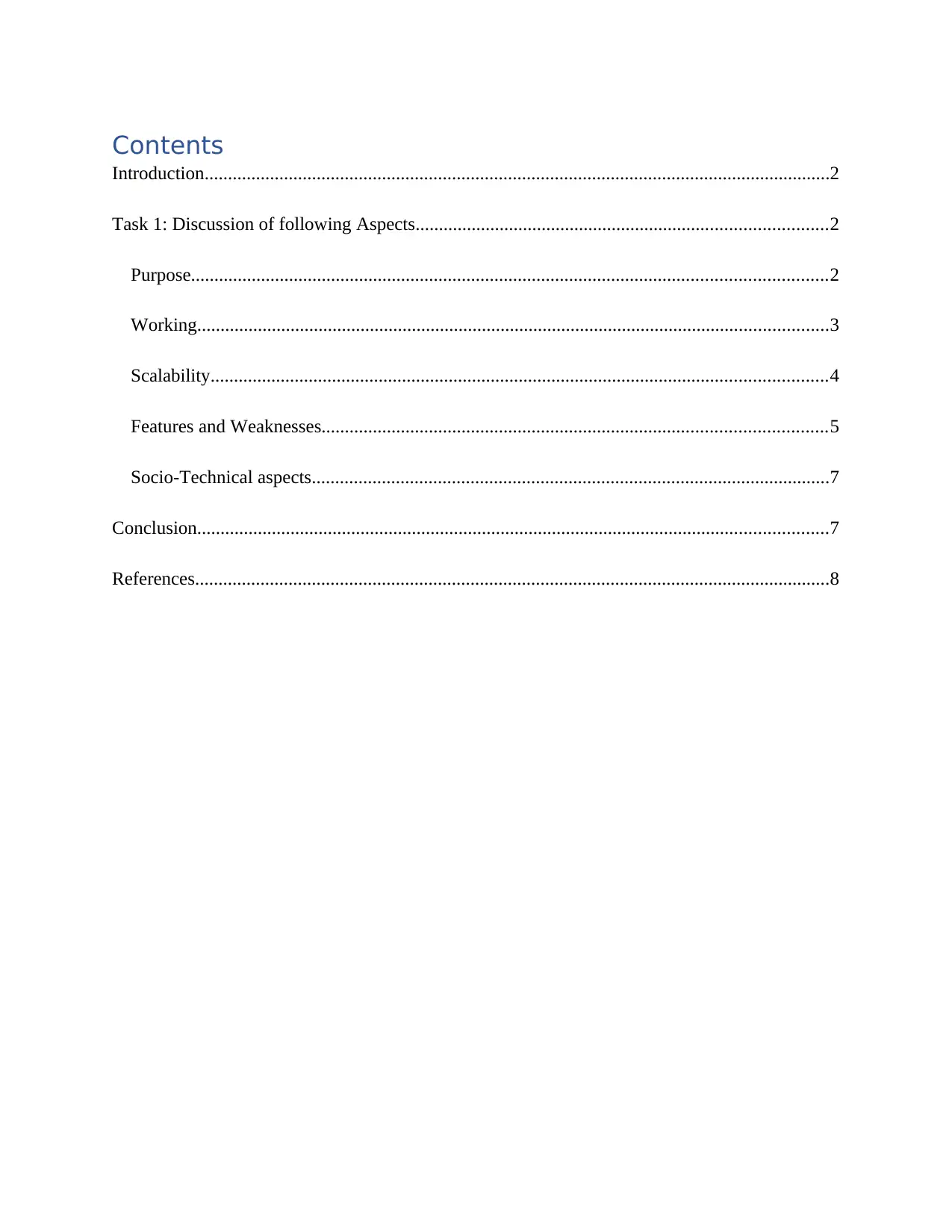
Contents
Introduction......................................................................................................................................2
Task 1: Discussion of following Aspects........................................................................................2
Purpose........................................................................................................................................2
Working.......................................................................................................................................3
Scalability....................................................................................................................................4
Features and Weaknesses............................................................................................................5
Socio-Technical aspects...............................................................................................................7
Conclusion.......................................................................................................................................7
References........................................................................................................................................8
Introduction......................................................................................................................................2
Task 1: Discussion of following Aspects........................................................................................2
Purpose........................................................................................................................................2
Working.......................................................................................................................................3
Scalability....................................................................................................................................4
Features and Weaknesses............................................................................................................5
Socio-Technical aspects...............................................................................................................7
Conclusion.......................................................................................................................................7
References........................................................................................................................................8
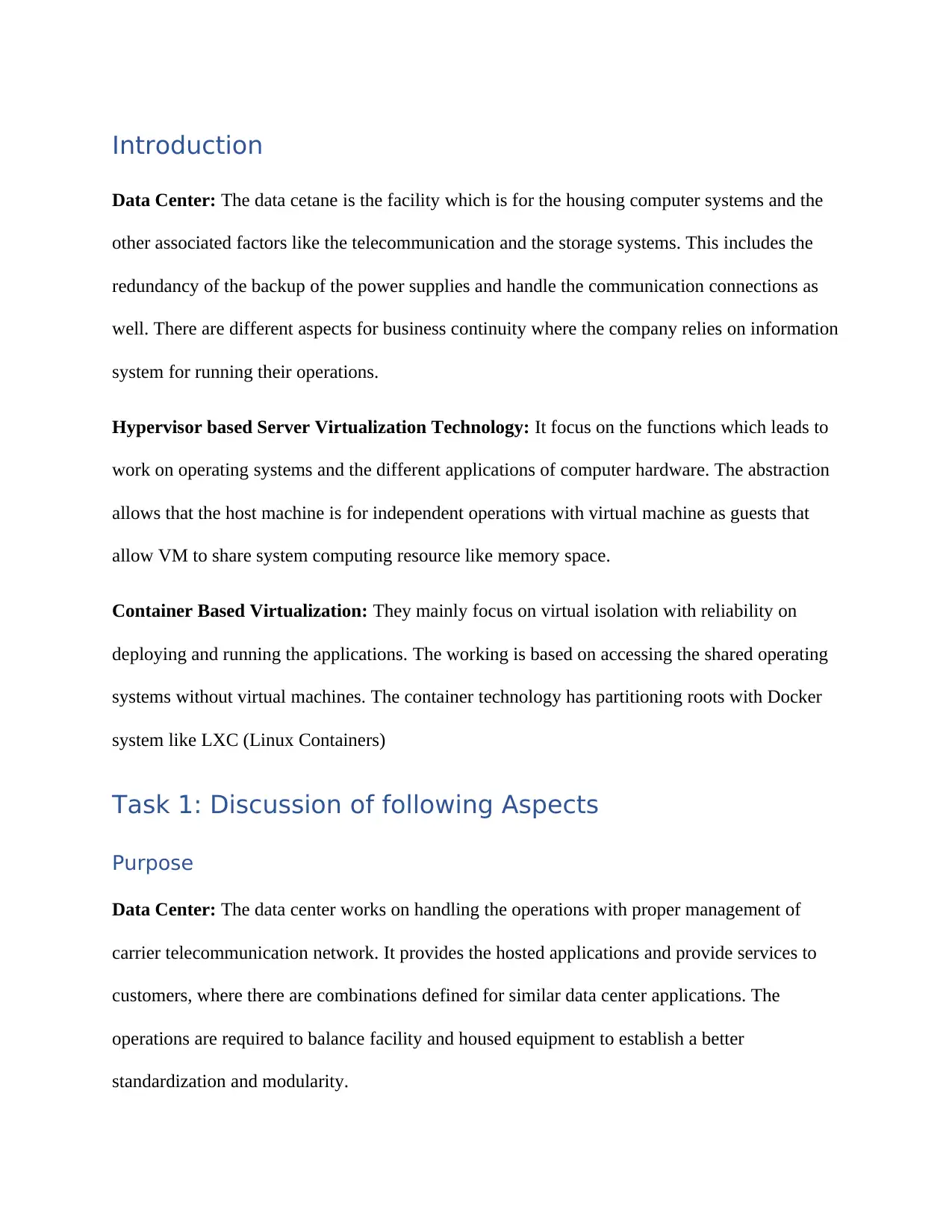
Introduction
Data Center: The data cetane is the facility which is for the housing computer systems and the
other associated factors like the telecommunication and the storage systems. This includes the
redundancy of the backup of the power supplies and handle the communication connections as
well. There are different aspects for business continuity where the company relies on information
system for running their operations.
Hypervisor based Server Virtualization Technology: It focus on the functions which leads to
work on operating systems and the different applications of computer hardware. The abstraction
allows that the host machine is for independent operations with virtual machine as guests that
allow VM to share system computing resource like memory space.
Container Based Virtualization: They mainly focus on virtual isolation with reliability on
deploying and running the applications. The working is based on accessing the shared operating
systems without virtual machines. The container technology has partitioning roots with Docker
system like LXC (Linux Containers)
Task 1: Discussion of following Aspects
Purpose
Data Center: The data center works on handling the operations with proper management of
carrier telecommunication network. It provides the hosted applications and provide services to
customers, where there are combinations defined for similar data center applications. The
operations are required to balance facility and housed equipment to establish a better
standardization and modularity.
Data Center: The data cetane is the facility which is for the housing computer systems and the
other associated factors like the telecommunication and the storage systems. This includes the
redundancy of the backup of the power supplies and handle the communication connections as
well. There are different aspects for business continuity where the company relies on information
system for running their operations.
Hypervisor based Server Virtualization Technology: It focus on the functions which leads to
work on operating systems and the different applications of computer hardware. The abstraction
allows that the host machine is for independent operations with virtual machine as guests that
allow VM to share system computing resource like memory space.
Container Based Virtualization: They mainly focus on virtual isolation with reliability on
deploying and running the applications. The working is based on accessing the shared operating
systems without virtual machines. The container technology has partitioning roots with Docker
system like LXC (Linux Containers)
Task 1: Discussion of following Aspects
Purpose
Data Center: The data center works on handling the operations with proper management of
carrier telecommunication network. It provides the hosted applications and provide services to
customers, where there are combinations defined for similar data center applications. The
operations are required to balance facility and housed equipment to establish a better
standardization and modularity.
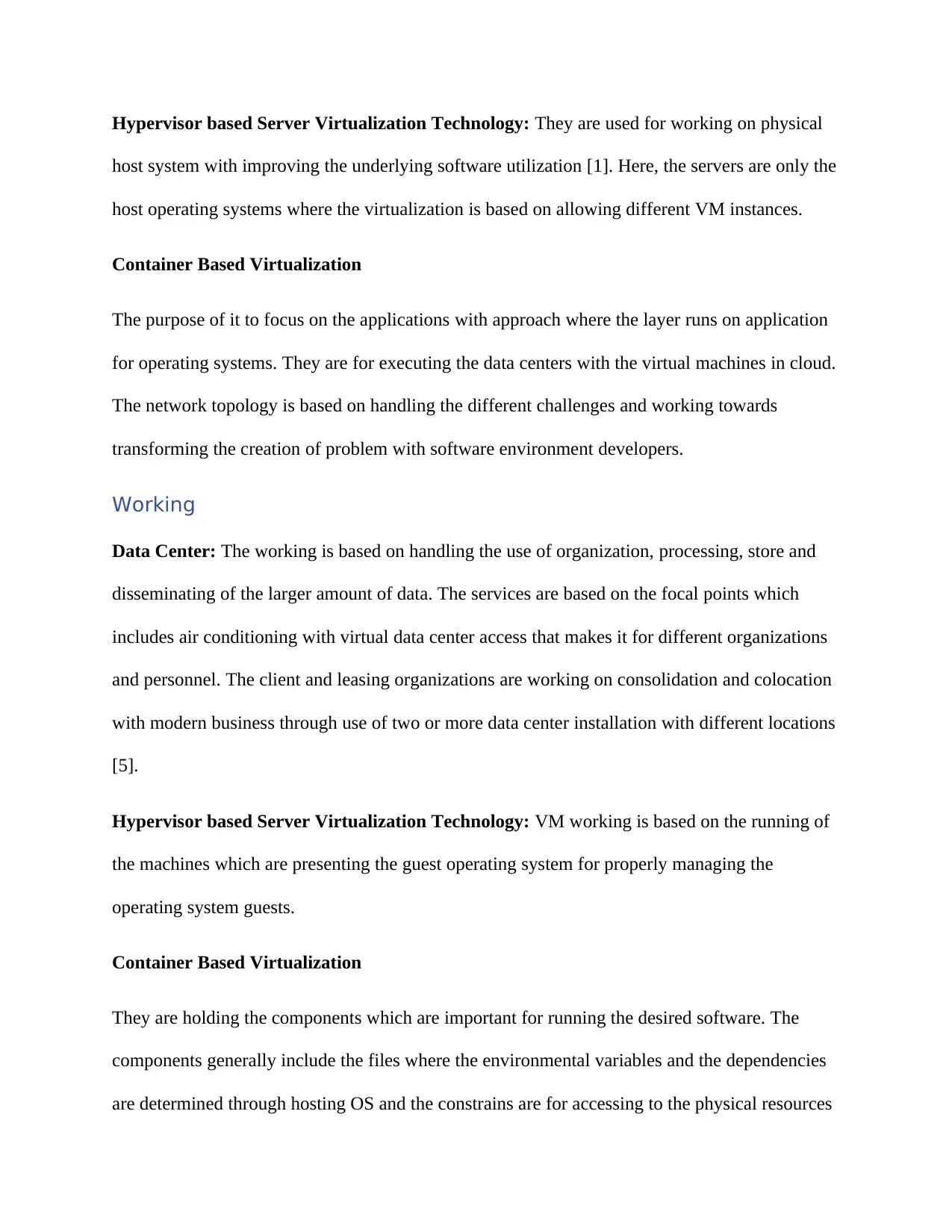
Hypervisor based Server Virtualization Technology: They are used for working on physical
host system with improving the underlying software utilization [1]. Here, the servers are only the
host operating systems where the virtualization is based on allowing different VM instances.
Container Based Virtualization
The purpose of it to focus on the applications with approach where the layer runs on application
for operating systems. They are for executing the data centers with the virtual machines in cloud.
The network topology is based on handling the different challenges and working towards
transforming the creation of problem with software environment developers.
Working
Data Center: The working is based on handling the use of organization, processing, store and
disseminating of the larger amount of data. The services are based on the focal points which
includes air conditioning with virtual data center access that makes it for different organizations
and personnel. The client and leasing organizations are working on consolidation and colocation
with modern business through use of two or more data center installation with different locations
[5].
Hypervisor based Server Virtualization Technology: VM working is based on the running of
the machines which are presenting the guest operating system for properly managing the
operating system guests.
Container Based Virtualization
They are holding the components which are important for running the desired software. The
components generally include the files where the environmental variables and the dependencies
are determined through hosting OS and the constrains are for accessing to the physical resources
host system with improving the underlying software utilization [1]. Here, the servers are only the
host operating systems where the virtualization is based on allowing different VM instances.
Container Based Virtualization
The purpose of it to focus on the applications with approach where the layer runs on application
for operating systems. They are for executing the data centers with the virtual machines in cloud.
The network topology is based on handling the different challenges and working towards
transforming the creation of problem with software environment developers.
Working
Data Center: The working is based on handling the use of organization, processing, store and
disseminating of the larger amount of data. The services are based on the focal points which
includes air conditioning with virtual data center access that makes it for different organizations
and personnel. The client and leasing organizations are working on consolidation and colocation
with modern business through use of two or more data center installation with different locations
[5].
Hypervisor based Server Virtualization Technology: VM working is based on the running of
the machines which are presenting the guest operating system for properly managing the
operating system guests.
Container Based Virtualization
They are holding the components which are important for running the desired software. The
components generally include the files where the environmental variables and the dependencies
are determined through hosting OS and the constrains are for accessing to the physical resources
Secure Best Marks with AI Grader
Need help grading? Try our AI Grader for instant feedback on your assignments.
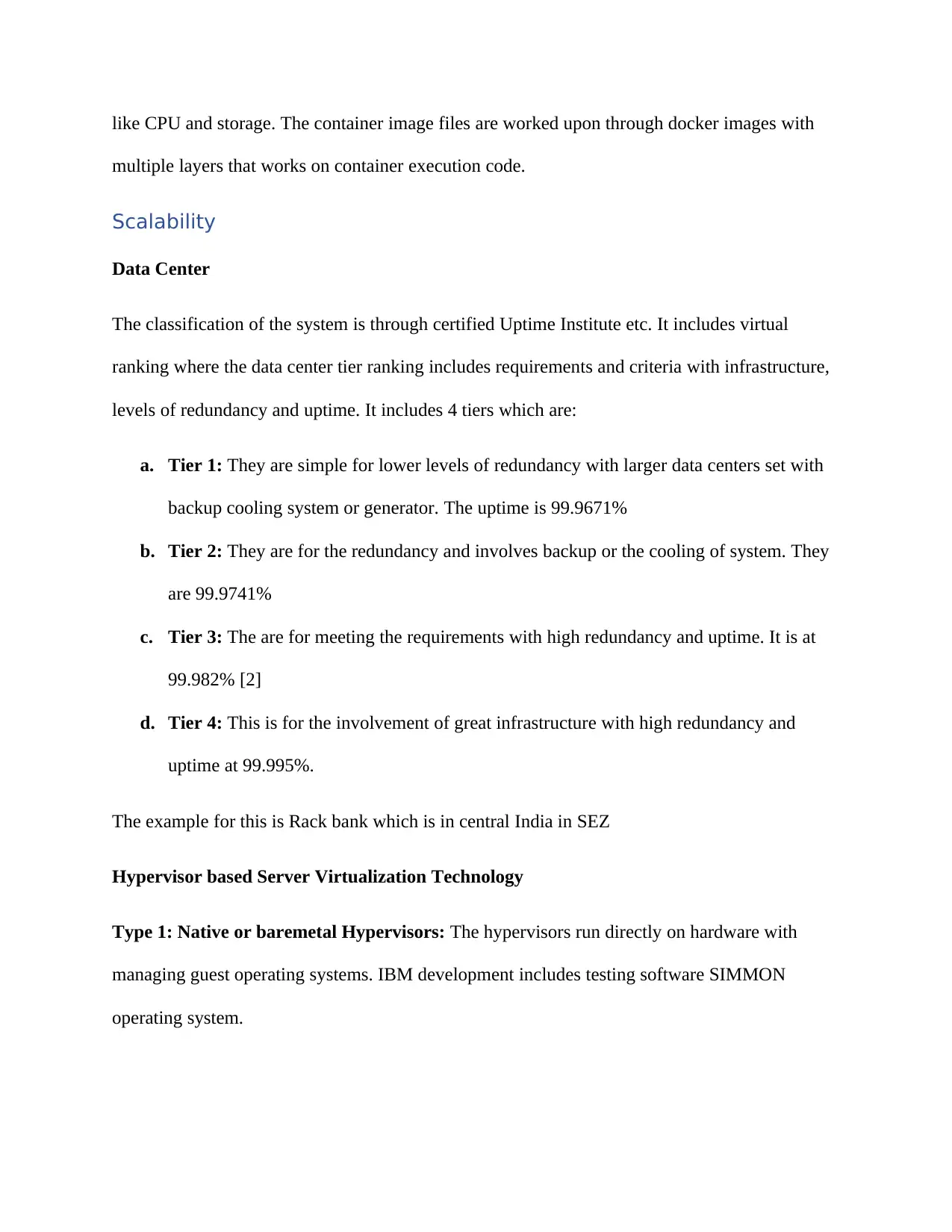
like CPU and storage. The container image files are worked upon through docker images with
multiple layers that works on container execution code.
Scalability
Data Center
The classification of the system is through certified Uptime Institute etc. It includes virtual
ranking where the data center tier ranking includes requirements and criteria with infrastructure,
levels of redundancy and uptime. It includes 4 tiers which are:
a. Tier 1: They are simple for lower levels of redundancy with larger data centers set with
backup cooling system or generator. The uptime is 99.9671%
b. Tier 2: They are for the redundancy and involves backup or the cooling of system. They
are 99.9741%
c. Tier 3: The are for meeting the requirements with high redundancy and uptime. It is at
99.982% [2]
d. Tier 4: This is for the involvement of great infrastructure with high redundancy and
uptime at 99.995%.
The example for this is Rack bank which is in central India in SEZ
Hypervisor based Server Virtualization Technology
Type 1: Native or baremetal Hypervisors: The hypervisors run directly on hardware with
managing guest operating systems. IBM development includes testing software SIMMON
operating system.
multiple layers that works on container execution code.
Scalability
Data Center
The classification of the system is through certified Uptime Institute etc. It includes virtual
ranking where the data center tier ranking includes requirements and criteria with infrastructure,
levels of redundancy and uptime. It includes 4 tiers which are:
a. Tier 1: They are simple for lower levels of redundancy with larger data centers set with
backup cooling system or generator. The uptime is 99.9671%
b. Tier 2: They are for the redundancy and involves backup or the cooling of system. They
are 99.9741%
c. Tier 3: The are for meeting the requirements with high redundancy and uptime. It is at
99.982% [2]
d. Tier 4: This is for the involvement of great infrastructure with high redundancy and
uptime at 99.995%.
The example for this is Rack bank which is in central India in SEZ
Hypervisor based Server Virtualization Technology
Type 1: Native or baremetal Hypervisors: The hypervisors run directly on hardware with
managing guest operating systems. IBM development includes testing software SIMMON
operating system.
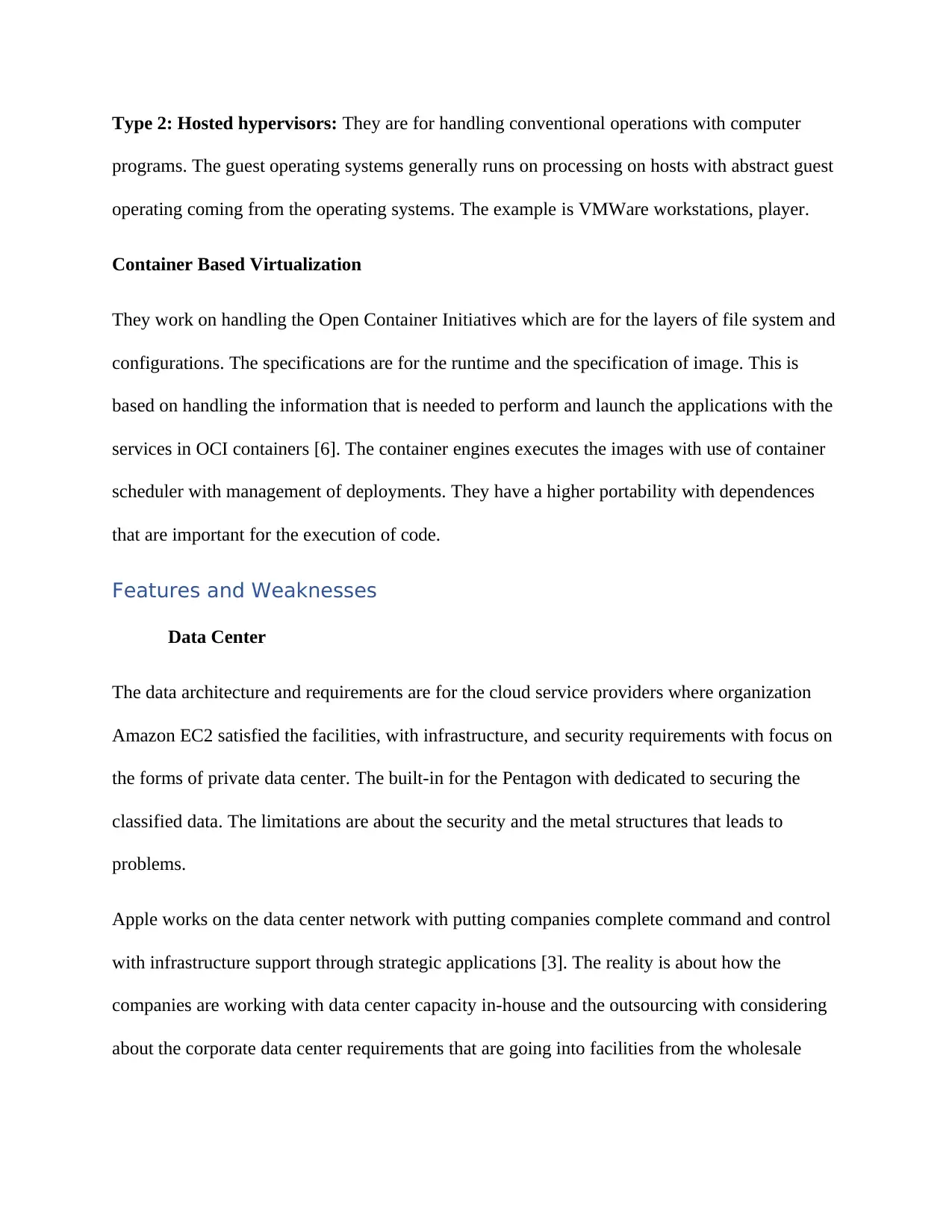
Type 2: Hosted hypervisors: They are for handling conventional operations with computer
programs. The guest operating systems generally runs on processing on hosts with abstract guest
operating coming from the operating systems. The example is VMWare workstations, player.
Container Based Virtualization
They work on handling the Open Container Initiatives which are for the layers of file system and
configurations. The specifications are for the runtime and the specification of image. This is
based on handling the information that is needed to perform and launch the applications with the
services in OCI containers [6]. The container engines executes the images with use of container
scheduler with management of deployments. They have a higher portability with dependences
that are important for the execution of code.
Features and Weaknesses
Data Center
The data architecture and requirements are for the cloud service providers where organization
Amazon EC2 satisfied the facilities, with infrastructure, and security requirements with focus on
the forms of private data center. The built-in for the Pentagon with dedicated to securing the
classified data. The limitations are about the security and the metal structures that leads to
problems.
Apple works on the data center network with putting companies complete command and control
with infrastructure support through strategic applications [3]. The reality is about how the
companies are working with data center capacity in-house and the outsourcing with considering
about the corporate data center requirements that are going into facilities from the wholesale
programs. The guest operating systems generally runs on processing on hosts with abstract guest
operating coming from the operating systems. The example is VMWare workstations, player.
Container Based Virtualization
They work on handling the Open Container Initiatives which are for the layers of file system and
configurations. The specifications are for the runtime and the specification of image. This is
based on handling the information that is needed to perform and launch the applications with the
services in OCI containers [6]. The container engines executes the images with use of container
scheduler with management of deployments. They have a higher portability with dependences
that are important for the execution of code.
Features and Weaknesses
Data Center
The data architecture and requirements are for the cloud service providers where organization
Amazon EC2 satisfied the facilities, with infrastructure, and security requirements with focus on
the forms of private data center. The built-in for the Pentagon with dedicated to securing the
classified data. The limitations are about the security and the metal structures that leads to
problems.
Apple works on the data center network with putting companies complete command and control
with infrastructure support through strategic applications [3]. The reality is about how the
companies are working with data center capacity in-house and the outsourcing with considering
about the corporate data center requirements that are going into facilities from the wholesale
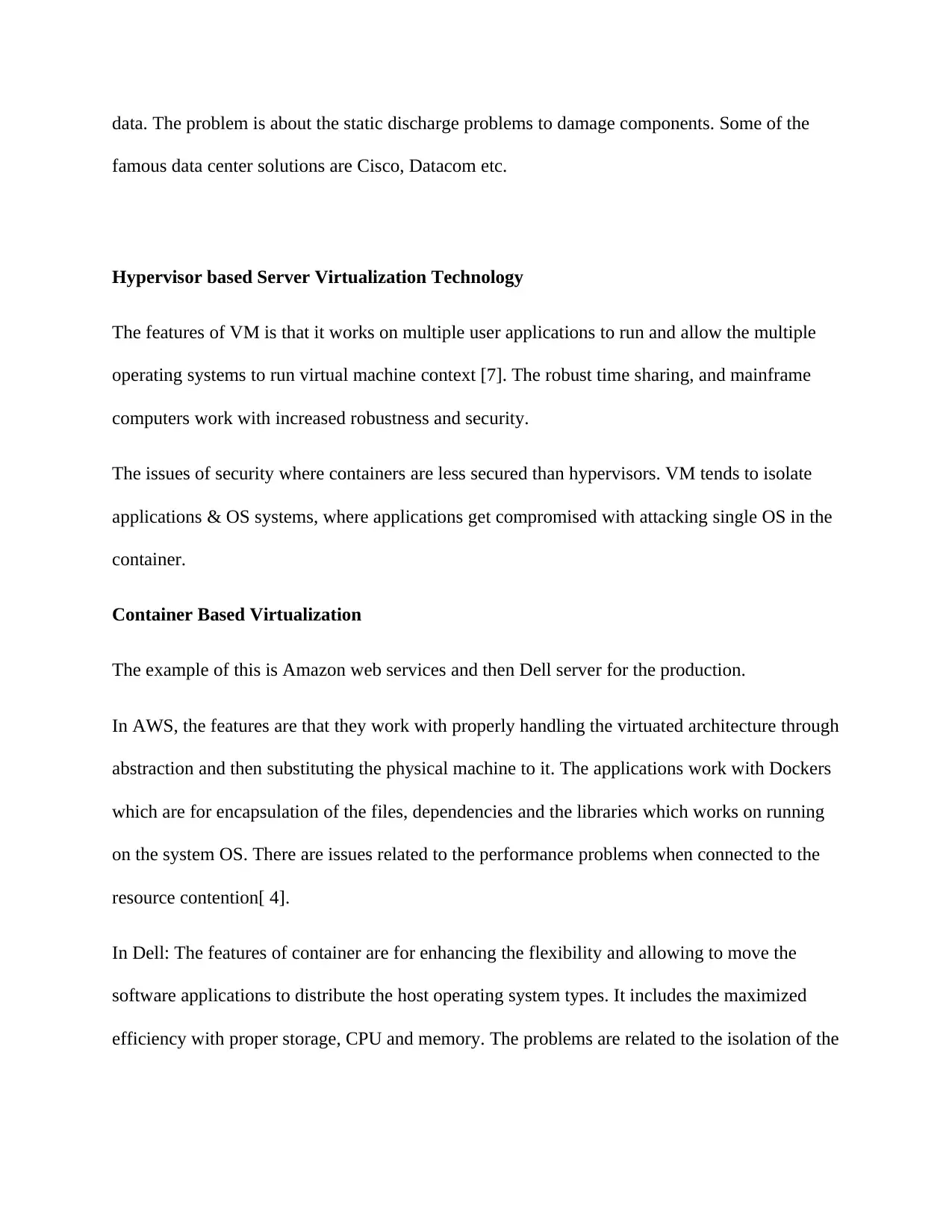
data. The problem is about the static discharge problems to damage components. Some of the
famous data center solutions are Cisco, Datacom etc.
Hypervisor based Server Virtualization Technology
The features of VM is that it works on multiple user applications to run and allow the multiple
operating systems to run virtual machine context [7]. The robust time sharing, and mainframe
computers work with increased robustness and security.
The issues of security where containers are less secured than hypervisors. VM tends to isolate
applications & OS systems, where applications get compromised with attacking single OS in the
container.
Container Based Virtualization
The example of this is Amazon web services and then Dell server for the production.
In AWS, the features are that they work with properly handling the virtuated architecture through
abstraction and then substituting the physical machine to it. The applications work with Dockers
which are for encapsulation of the files, dependencies and the libraries which works on running
on the system OS. There are issues related to the performance problems when connected to the
resource contention[ 4].
In Dell: The features of container are for enhancing the flexibility and allowing to move the
software applications to distribute the host operating system types. It includes the maximized
efficiency with proper storage, CPU and memory. The problems are related to the isolation of the
famous data center solutions are Cisco, Datacom etc.
Hypervisor based Server Virtualization Technology
The features of VM is that it works on multiple user applications to run and allow the multiple
operating systems to run virtual machine context [7]. The robust time sharing, and mainframe
computers work with increased robustness and security.
The issues of security where containers are less secured than hypervisors. VM tends to isolate
applications & OS systems, where applications get compromised with attacking single OS in the
container.
Container Based Virtualization
The example of this is Amazon web services and then Dell server for the production.
In AWS, the features are that they work with properly handling the virtuated architecture through
abstraction and then substituting the physical machine to it. The applications work with Dockers
which are for encapsulation of the files, dependencies and the libraries which works on running
on the system OS. There are issues related to the performance problems when connected to the
resource contention[ 4].
In Dell: The features of container are for enhancing the flexibility and allowing to move the
software applications to distribute the host operating system types. It includes the maximized
efficiency with proper storage, CPU and memory. The problems are related to the isolation of the
Paraphrase This Document
Need a fresh take? Get an instant paraphrase of this document with our AI Paraphraser
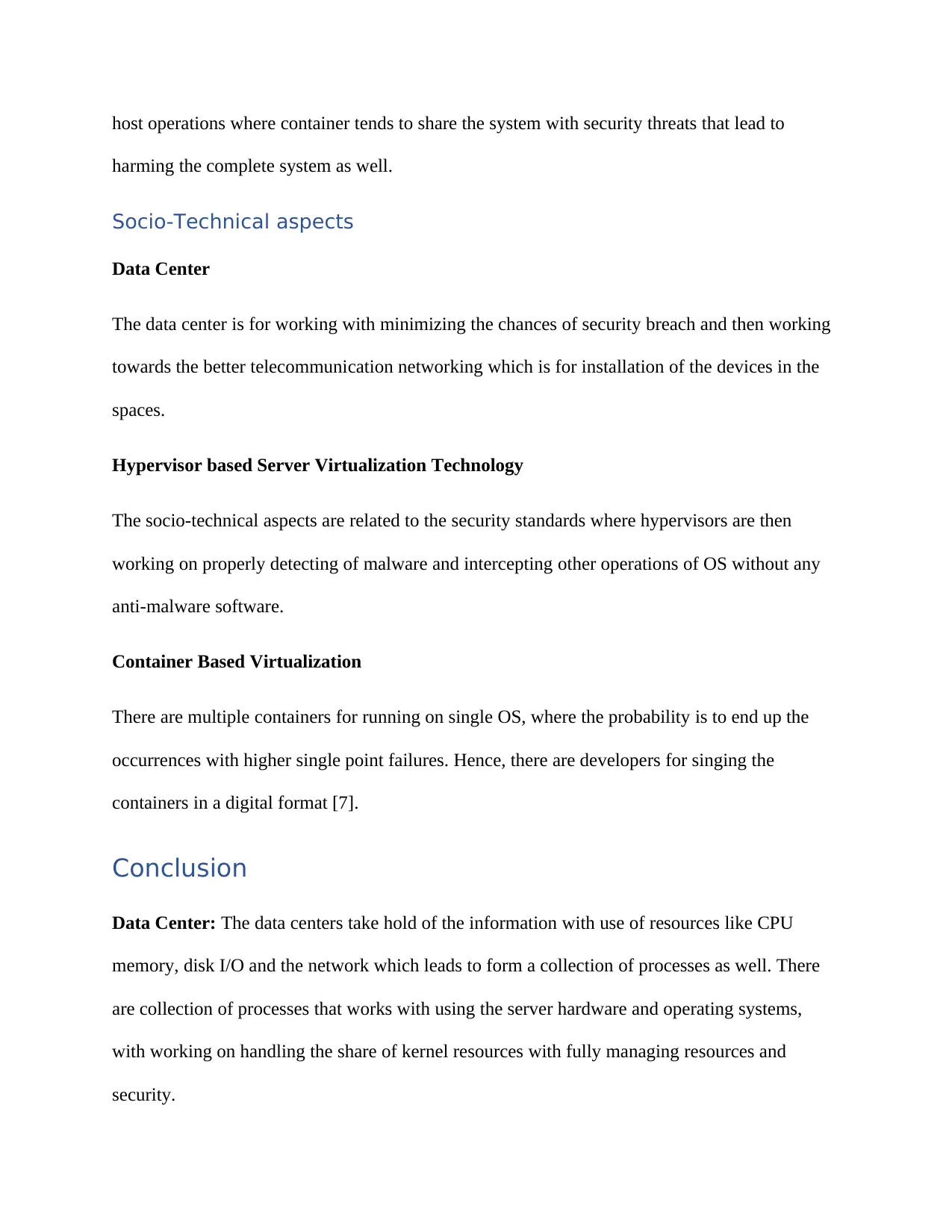
host operations where container tends to share the system with security threats that lead to
harming the complete system as well.
Socio-Technical aspects
Data Center
The data center is for working with minimizing the chances of security breach and then working
towards the better telecommunication networking which is for installation of the devices in the
spaces.
Hypervisor based Server Virtualization Technology
The socio-technical aspects are related to the security standards where hypervisors are then
working on properly detecting of malware and intercepting other operations of OS without any
anti-malware software.
Container Based Virtualization
There are multiple containers for running on single OS, where the probability is to end up the
occurrences with higher single point failures. Hence, there are developers for singing the
containers in a digital format [7].
Conclusion
Data Center: The data centers take hold of the information with use of resources like CPU
memory, disk I/O and the network which leads to form a collection of processes as well. There
are collection of processes that works with using the server hardware and operating systems,
with working on handling the share of kernel resources with fully managing resources and
security.
harming the complete system as well.
Socio-Technical aspects
Data Center
The data center is for working with minimizing the chances of security breach and then working
towards the better telecommunication networking which is for installation of the devices in the
spaces.
Hypervisor based Server Virtualization Technology
The socio-technical aspects are related to the security standards where hypervisors are then
working on properly detecting of malware and intercepting other operations of OS without any
anti-malware software.
Container Based Virtualization
There are multiple containers for running on single OS, where the probability is to end up the
occurrences with higher single point failures. Hence, there are developers for singing the
containers in a digital format [7].
Conclusion
Data Center: The data centers take hold of the information with use of resources like CPU
memory, disk I/O and the network which leads to form a collection of processes as well. There
are collection of processes that works with using the server hardware and operating systems,
with working on handling the share of kernel resources with fully managing resources and
security.
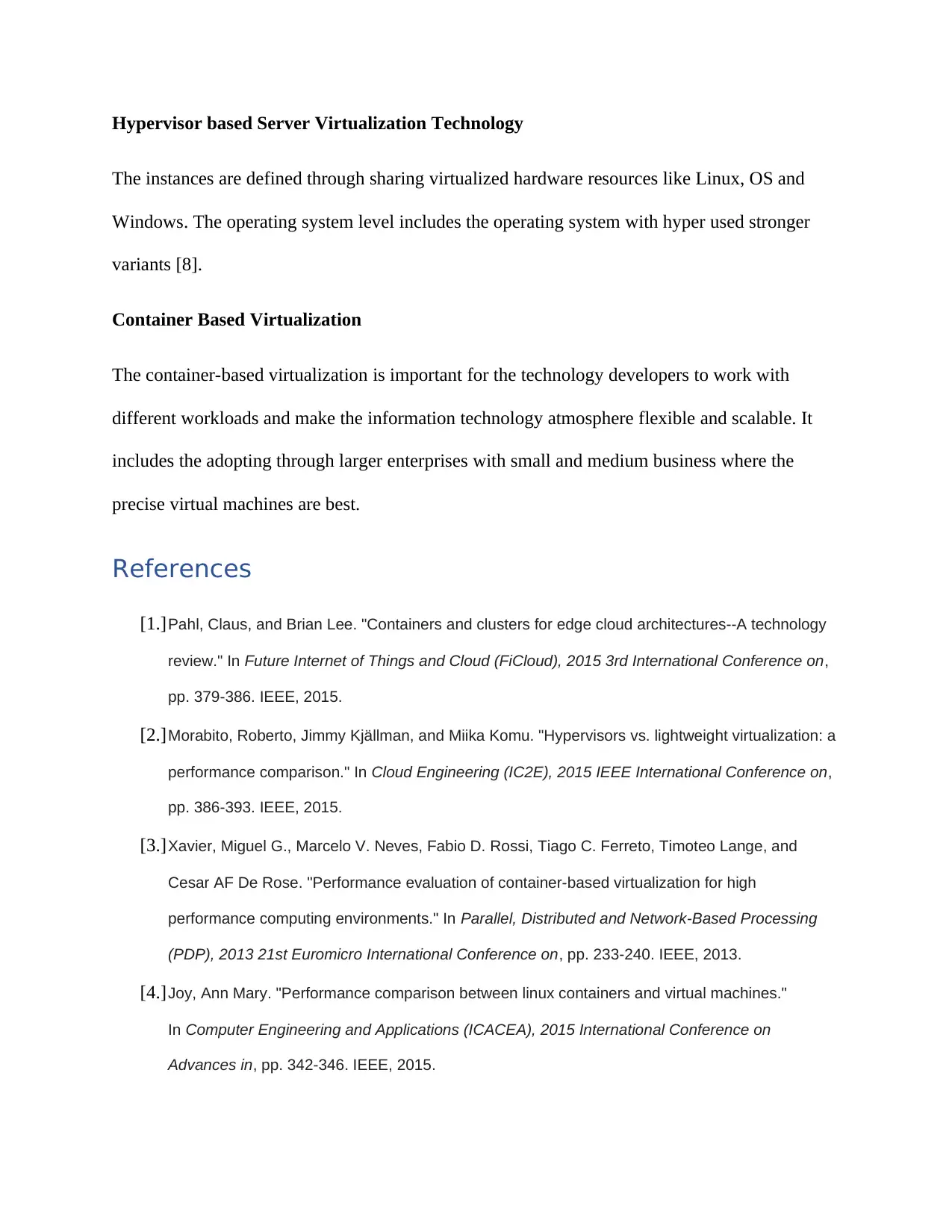
Hypervisor based Server Virtualization Technology
The instances are defined through sharing virtualized hardware resources like Linux, OS and
Windows. The operating system level includes the operating system with hyper used stronger
variants [8].
Container Based Virtualization
The container-based virtualization is important for the technology developers to work with
different workloads and make the information technology atmosphere flexible and scalable. It
includes the adopting through larger enterprises with small and medium business where the
precise virtual machines are best.
References
[1.]Pahl, Claus, and Brian Lee. "Containers and clusters for edge cloud architectures--A technology
review." In Future Internet of Things and Cloud (FiCloud), 2015 3rd International Conference on,
pp. 379-386. IEEE, 2015.
[2.]Morabito, Roberto, Jimmy Kjällman, and Miika Komu. "Hypervisors vs. lightweight virtualization: a
performance comparison." In Cloud Engineering (IC2E), 2015 IEEE International Conference on,
pp. 386-393. IEEE, 2015.
[3.]Xavier, Miguel G., Marcelo V. Neves, Fabio D. Rossi, Tiago C. Ferreto, Timoteo Lange, and
Cesar AF De Rose. "Performance evaluation of container-based virtualization for high
performance computing environments." In Parallel, Distributed and Network-Based Processing
(PDP), 2013 21st Euromicro International Conference on, pp. 233-240. IEEE, 2013.
[4.]Joy, Ann Mary. "Performance comparison between linux containers and virtual machines."
In Computer Engineering and Applications (ICACEA), 2015 International Conference on
Advances in, pp. 342-346. IEEE, 2015.
The instances are defined through sharing virtualized hardware resources like Linux, OS and
Windows. The operating system level includes the operating system with hyper used stronger
variants [8].
Container Based Virtualization
The container-based virtualization is important for the technology developers to work with
different workloads and make the information technology atmosphere flexible and scalable. It
includes the adopting through larger enterprises with small and medium business where the
precise virtual machines are best.
References
[1.]Pahl, Claus, and Brian Lee. "Containers and clusters for edge cloud architectures--A technology
review." In Future Internet of Things and Cloud (FiCloud), 2015 3rd International Conference on,
pp. 379-386. IEEE, 2015.
[2.]Morabito, Roberto, Jimmy Kjällman, and Miika Komu. "Hypervisors vs. lightweight virtualization: a
performance comparison." In Cloud Engineering (IC2E), 2015 IEEE International Conference on,
pp. 386-393. IEEE, 2015.
[3.]Xavier, Miguel G., Marcelo V. Neves, Fabio D. Rossi, Tiago C. Ferreto, Timoteo Lange, and
Cesar AF De Rose. "Performance evaluation of container-based virtualization for high
performance computing environments." In Parallel, Distributed and Network-Based Processing
(PDP), 2013 21st Euromicro International Conference on, pp. 233-240. IEEE, 2013.
[4.]Joy, Ann Mary. "Performance comparison between linux containers and virtual machines."
In Computer Engineering and Applications (ICACEA), 2015 International Conference on
Advances in, pp. 342-346. IEEE, 2015.
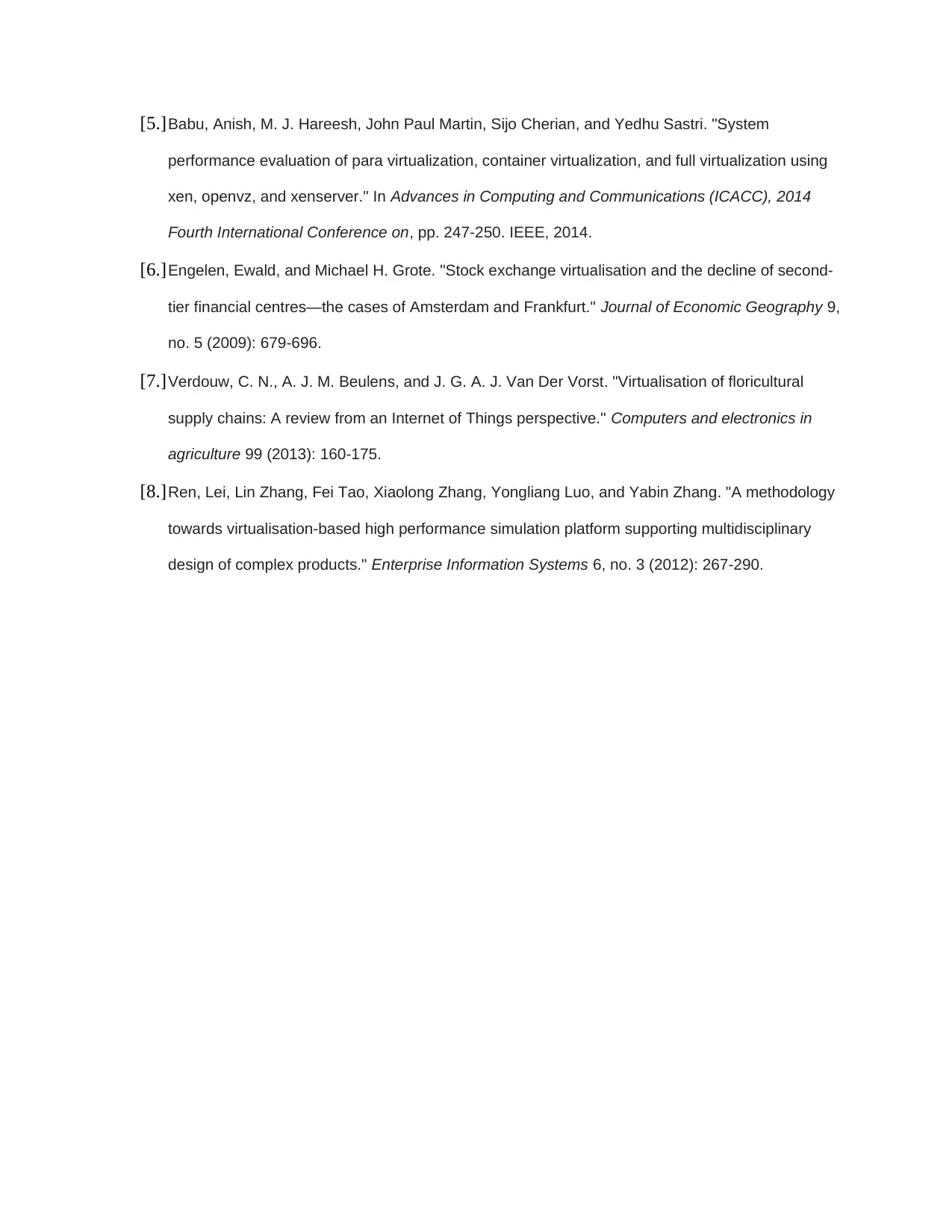
[5.]Babu, Anish, M. J. Hareesh, John Paul Martin, Sijo Cherian, and Yedhu Sastri. "System
performance evaluation of para virtualization, container virtualization, and full virtualization using
xen, openvz, and xenserver." In Advances in Computing and Communications (ICACC), 2014
Fourth International Conference on, pp. 247-250. IEEE, 2014.
[6.]Engelen, Ewald, and Michael H. Grote. "Stock exchange virtualisation and the decline of second-
tier financial centres—the cases of Amsterdam and Frankfurt." Journal of Economic Geography 9,
no. 5 (2009): 679-696.
[7.]Verdouw, C. N., A. J. M. Beulens, and J. G. A. J. Van Der Vorst. "Virtualisation of floricultural
supply chains: A review from an Internet of Things perspective." Computers and electronics in
agriculture 99 (2013): 160-175.
[8.]Ren, Lei, Lin Zhang, Fei Tao, Xiaolong Zhang, Yongliang Luo, and Yabin Zhang. "A methodology
towards virtualisation-based high performance simulation platform supporting multidisciplinary
design of complex products." Enterprise Information Systems 6, no. 3 (2012): 267-290.
performance evaluation of para virtualization, container virtualization, and full virtualization using
xen, openvz, and xenserver." In Advances in Computing and Communications (ICACC), 2014
Fourth International Conference on, pp. 247-250. IEEE, 2014.
[6.]Engelen, Ewald, and Michael H. Grote. "Stock exchange virtualisation and the decline of second-
tier financial centres—the cases of Amsterdam and Frankfurt." Journal of Economic Geography 9,
no. 5 (2009): 679-696.
[7.]Verdouw, C. N., A. J. M. Beulens, and J. G. A. J. Van Der Vorst. "Virtualisation of floricultural
supply chains: A review from an Internet of Things perspective." Computers and electronics in
agriculture 99 (2013): 160-175.
[8.]Ren, Lei, Lin Zhang, Fei Tao, Xiaolong Zhang, Yongliang Luo, and Yabin Zhang. "A methodology
towards virtualisation-based high performance simulation platform supporting multidisciplinary
design of complex products." Enterprise Information Systems 6, no. 3 (2012): 267-290.
1 out of 10
Related Documents
Your All-in-One AI-Powered Toolkit for Academic Success.
+13062052269
info@desklib.com
Available 24*7 on WhatsApp / Email
![[object Object]](/_next/static/media/star-bottom.7253800d.svg)
Unlock your academic potential
© 2024 | Zucol Services PVT LTD | All rights reserved.





